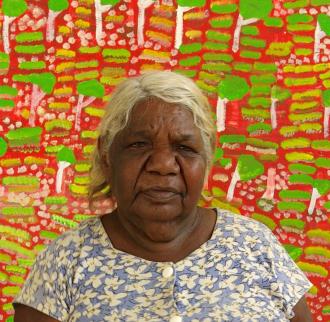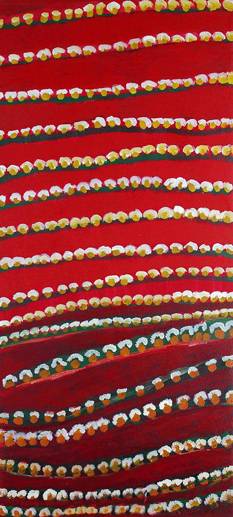TARKU ROSIE TARCO KING
Japirnka
8/17
Acrylic Paint on 3mm Poly-Carbonate
60 x 120cm | 23.62 x 47.24in
Mangkaja Artists
ENQUIRE
TARKU ROSIE TARCO KING
Jilji & Partiri
179/06
Acrylic on cotton
100 x 45cm | 39.37 x 17.72in
Mangkaja Artists
ENQUIRE
TARKU ROSIE TARCO KING
Jilji Country
wp358/05
Acrylic on paper
76 x 56cm | 29.92 x 22.05in
Mangkaja Artists
ENQUIRE
Date of Birth:01.01.32 Language:Walmajarri Country:Payinjarra, Great Sandy Desert I was born at a jumu [soak water] called Payinjarra in the Great Sandy Desert.
I walked out from the desert with my husband when I was a young girl.
I left my mother and brother Kumanjayi [deceased] Pijaju behind at Japingka.
My husband had two wives, my older sister and myself.
These two passed away a long time ago, here in the river country at Brooking Springs Station.
When we left the desert we walked for a long time.
We were walking and hunting all the way.
We killed pussycat and wirlka [sand goanna] for food but no kangaroo.
I was walking and worrying all the time about my mother but I kept going.
My husband and my sister were both cheeky.
They hit me for no reason.
I was crying for my mother.
I got away from them once.
But they were too cheeky to me and told me, “come on you have to go”.
I told them, “No, I want to go back to my mother”.
They kept telling me “No, you have to keep going”.
I was frightened but I came out at Old Bililluna.
There was a plane landing right there and I was frightened of that plane.
From there, all of us kids went walking and looking at the plane which had landed.
I didn’t know any English and so I just looked at the kartiya [Europeans].
We kept going and we saw kartiya getting water in a bucket from a well.
This was new to me too because it was the first time I had seen this.
We had no shoes.
We were wearing yakapiri [bush used to make sandals to protect feet from the hot ground].
After that, a motorcar came from Moola Bulla to Old Bililluna and took us to Moola Bulla.
We were frightened in the car.
We hadn’t seen one before.
And we didn’t know anyone there either.
I met Manmarria Daisy Andrews and her first son at Moola Bulla.
Collections: National Museum of Australia Fitzroy Crossing High School Fitzroy Crossing Hospital
.Date of Birth:01.01.32 Language:Walmajarri Country:Payinjarra, Great Sandy Desert I was born at a jumu [soak water] called Payinjarra in the Great Sandy Desert.
I walked out from the desert with my husband when I was a young girl.
I left my mother and brother Kumanjayi [deceased] Pijaju behind at Japingka.
My husband had two wives, my older sister and myself.
These two passed away a long time ago, here in the river country at Brooking Springs Station.
When we left the desert we walked for a long time.
We were walking and hunting all the way.
We killed pussycat and wirlka [sand goanna] for food but no kangaroo.
I was walking and worrying all the time about my mother but I kept going.
My husband and my sister were both cheeky.
They hit me for no reason.
I was crying for my mother.
I got away from them once.
But they were too cheeky to me and told me, “come on you have to go”.
I told them, “No, I want to go back to my mother”.
They kept telling me “No, you have to keep going”.
I was frightened but I came out at Old Bililluna.
There was a plane landing right there and I was frightened of that plane.
From there, all of us kids went walking and looking at the plane which had landed.
I didn’t know any English and so I just looked at the kartiya [Europeans].
We kept going and we saw kartiya getting water in a bucket from a well.
This was new to me too because it was the first time I had seen this.
We had no shoes.
We were wearing yakapiri [bush used to make sandals to protect feet from the hot ground].
After that, a motorcar came from Moola Bulla to Old Bililluna and took us to Moola Bulla.
We were frightened in the car.
We hadn’t seen one before.
And we didn’t know anyone there either.
I met Manmarria Daisy Andrews and her first son at Moola Bulla.
Collections: National Museum of Australia Fitzroy Crossing High School Fitzroy Crossing Hospital
.![Australian Indigenous (Aboriginal and Torres Strait Islander) artwork by TARKU ROSIE TARCO KING of Mangkaja Artists. The title is Japirnka. [8/17] (Acrylic Paint on 3mm Poly-Carbonate)](https://media.redotgallery.com/stockroom/gallery/j/artwork/t/japirnka-4856-MEDIUM-3.jpg)
![Australian Indigenous (Aboriginal and Torres Strait Islander) artwork by TARKU ROSIE TARCO KING of Mangkaja Artists. The title is Jilji & Partiri. [179/06] (Acrylic on cotton)](https://media.redotgallery.com/stockroom/gallery/j/jilji-partiri-179.jpg)
![Australian Indigenous (Aboriginal and Torres Strait Islander) artwork by TARKU ROSIE TARCO KING of Mangkaja Artists. The title is Jilji Country. [wp358/05] (Acrylic on paper)](https://media.redotgallery.com/stockroom/gallery/j/artwork/t/jilji-country-609-MEDIUM-3.jpg)

